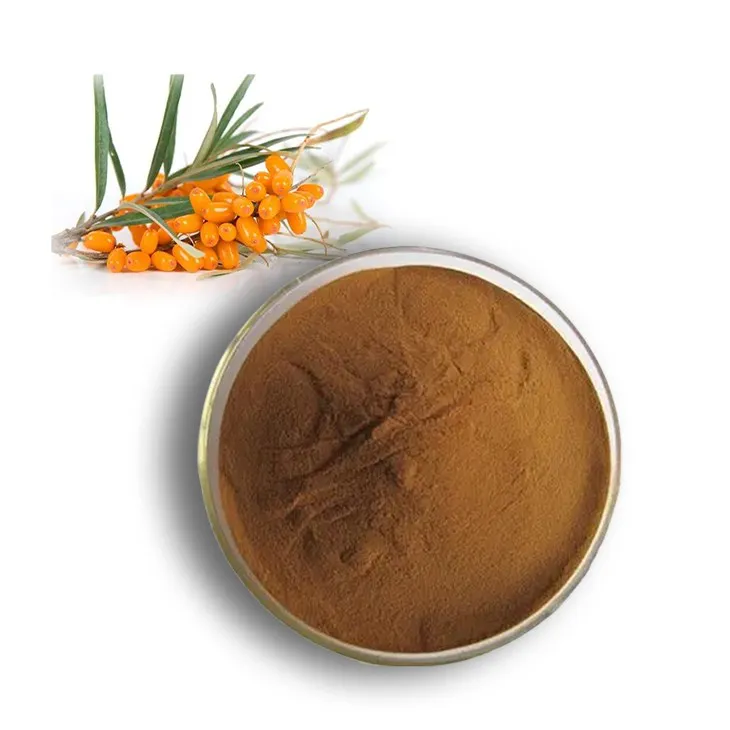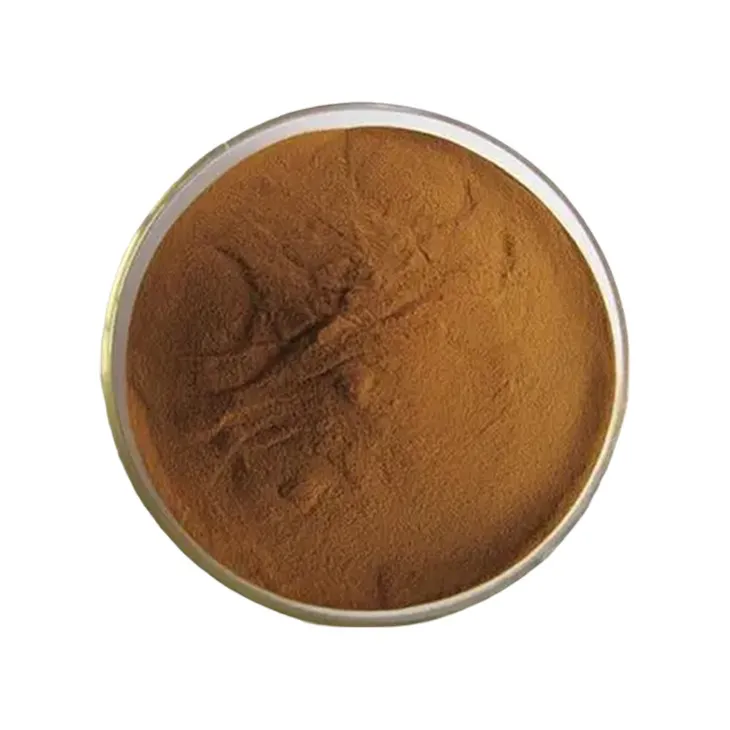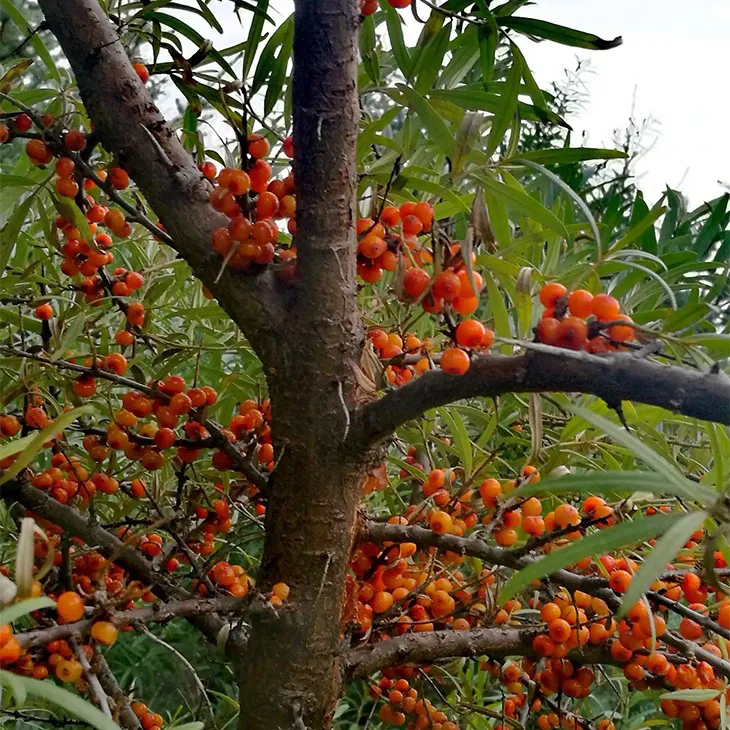- 0086-571-85302990
- sales@greenskybio.com
Fertilizer and feed components of seabuckthorn bark extracts.
2024-11-28

1. Introduction to Seabuckthorn
Seabuckthorn, a remarkable plant, is known for its rich resources. It is widely distributed in many regions. The seabuckthorn plant as a whole, and particularly its bark, contains a plethora of substances that are of great value. These substances are being increasingly explored for their potential applications in various fields, especially in fertilizers and feeds.

2. SeaBuckthorn bark extract in Fertilizers
2.1 Nutrient Composition
The seaBuckthorn bark extract is rich in nutrients, especially trace elements. These trace elements play a crucial role in plant growth. For example, elements like zinc, iron, and manganese are essential for various physiological processes in plants. Zinc is involved in enzyme activation, which is vital for photosynthesis and other metabolic activities. Iron is necessary for chlorophyll synthesis, and without sufficient iron, plants may suffer from chlorosis. Manganese also participates in enzyme reactions related to photosynthesis and respiration.
2.2 Improving Soil Fertility
When seaBuckthorn bark extract is added to the soil, it can enhance soil fertility in multiple ways. Firstly, it can improve the soil structure. The substances in the extract can bind soil particles together, creating a more stable and porous soil structure. This allows for better water infiltration and air circulation in the soil. Secondly, it enriches the soil with nutrients. The release of trace elements and other organic compounds from the extract provides a continuous source of nutrition for soil microorganisms. These microorganisms, in turn, play a role in decomposing organic matter and making nutrients more available to plants.
2.3 Promoting Plant Growth
The presence of seabuckthorn bark extract in the soil has a positive impact on plant growth. It can stimulate root development. The nutrients and bioactive compounds in the extract can encourage root elongation and branching. A well - developed root system enables plants to better absorb water and nutrients from the soil. Moreover, it can also promote above - ground growth. Plants treated with seabuckthorn bark extract often show increased shoot growth, more leaves, and larger leaf areas. This is attributed to the improved nutrient uptake and the stimulation of growth - related hormones within the plants.
2.4 Enhancing Plant Resistance to Diseases and Pests
Plants supplied with seabuckthorn bark extract tend to have enhanced resistance against diseases and pests. The bioactive compounds in the extract can act as natural defense agents. For instance, some compounds may induce the plant's own defense mechanisms, such as the production of phytoalexins. These are antimicrobial substances that plants produce in response to pathogen attacks. Additionally, the improved overall health of the plants due to better nutrition also makes them less susceptible to pests and diseases.

3. Seabuckthorn Bark Extract in Feeds
3.1 Bioactive Compounds
The seabuckthorn bark extract contains a variety of bioactive compounds that are beneficial for livestock and poultry. These compounds can have multiple positive effects on the animals. Some of these bioactive compounds have antioxidant properties. Antioxidants are important for neutralizing free radicals in the animals' bodies. Free radicals can cause oxidative damage to cells, which may lead to various health problems. By providing antioxidants, seabuckthorn bark extract can help maintain the health of cells and tissues in livestock and poultry.
3.2 Enhancing Immunity
One of the significant benefits of seabuckthorn bark extract in feeds is its ability to enhance the immunity of livestock and poultry. The bioactive compounds in the extract can stimulate the immune system of the animals. For example, they can enhance the function of immune cells such as lymphocytes and macrophages. Lymphocytes are responsible for recognizing and responding to foreign antigens, while macrophages play a role in engulfing and destroying pathogens. By strengthening the immune system, animals are better able to resist infections and diseases.
3.3 Improving Growth Performance
When seabuckthorn bark extract is included in the feed, it can improve the growth performance of livestock and poultry. The nutrients and bioactive compounds in the extract can enhance digestion and absorption. They can stimulate the secretion of digestive enzymes in the animals' digestive tracts, which helps break down food more efficiently. This leads to better nutrient utilization and ultimately results in increased weight gain, improved feed conversion ratio, and faster growth rate of the animals.
3.4 Contributing to the Quality of Animal Products
The use of seabuckthorn bark extract in feeds can also contribute to the quality of animal products. For example, in poultry, it may improve the quality of eggs. The eggs may have a better nutritional profile, with higher levels of certain beneficial nutrients. In livestock, it can affect the quality of meat. The meat may be more tender, have a better color, and contain more healthy fatty acids. This is because the bioactive compounds in the extract can influence the metabolism and physiological processes in the animals that are related to product quality.

4. Extraction and Processing of Seabuckthorn Bark Extract
4.1 Extraction Methods
There are several methods for extracting seabuckthorn bark extract. One common method is solvent extraction. In this method, a suitable solvent such as ethanol or water is used to extract the active substances from the seabuckthorn bark. Ethanol extraction is often preferred because it can extract a wide range of bioactive compounds. Another method is supercritical fluid extraction, which uses supercritical carbon dioxide as the extracting agent. This method has the advantage of being more environmentally friendly and can produce a high - quality extract with relatively pure compounds.
4.2 Processing and Purification
After extraction, the seabuckthorn bark extract usually needs to be processed and purified. Processing may involve steps such as concentration, where the solvent is removed to increase the concentration of the active substances. Purification can be achieved through techniques such as chromatography. Chromatography can separate different compounds in the extract based on their chemical properties, allowing for the isolation of specific bioactive compounds. This processed and purified extract is then more suitable for use in fertilizers and feeds.

5. Safety and Regulatory Considerations
5.1 Safety for Plants and Animals
Before using seabuckthorn bark extract in fertilizers and feeds, it is essential to ensure its safety for plants and animals. Extensive research and testing are required to determine the appropriate dosage and application methods. When used as a fertilizer, excessive amounts of the extract may cause nutrient imbalances in the soil or even toxicity to plants. In feeds, improper use may lead to adverse effects on the health of livestock and poultry. However, when used correctly, seabuckthorn bark extract has been shown to be generally safe and beneficial.
5.2 Regulatory Requirements
There are regulatory requirements governing the use of seabuckthorn bark extract in fertilizers and feeds. These regulations vary from country to country. In general, products containing seabuckthorn bark extract need to meet certain quality and safety standards. For fertilizers, there may be regulations regarding the nutrient content, labeling, and environmental impact. For feeds, there are regulations on feed additives, including requirements for safety assessment, maximum allowable levels, and proper labeling to ensure the safety of the animal products for human consumption.
6. Conclusion
In conclusion, seabuckthorn bark extract has great potential as a component in fertilizers and feeds. Its rich nutrient content and bioactive compounds offer numerous benefits for plants and animals. However, proper extraction, processing, and application are crucial to ensure its effectiveness and safety. With further research and development, seabuckthorn bark extract can be more widely and effectively utilized in the agricultural and livestock industries, contributing to more sustainable and high - quality production.
FAQ:
Q1: What are the main nutrients in seabuckthorn bark extract that can improve soil fertility?
Seabuckthorn bark extract is rich in trace elements. These trace elements play a crucial role in improving soil fertility. For example, they can participate in various physiological and biochemical processes of plants, enhance the activity of soil microorganisms, and thus contribute to better soil structure and nutrient availability.
Q2: How does seabuckthorn bark extract enhance plant resistance to diseases and pests?
The seabuckthorn bark extract may contain certain substances that can stimulate the plant's natural defense mechanisms. It might trigger the production of defense - related proteins or chemicals in plants. These substances can act as a deterrent to pests and help plants better withstand pathogen attacks.
Q3: What bioactive compounds are there in seabuckthorn bark extract for livestock and poultry?
There are various bioactive compounds in seabuckthorn bark extract for livestock and poultry. Some of them may include flavonoids, polyphenols, etc. These compounds can interact with the immune system of livestock and poultry, enhancing their immunity and overall health.
Q4: Can seabuckthorn bark extract directly replace traditional fertilizers or feeds?
Seabuckthorn bark extract cannot directly replace traditional fertilizers or feeds. While it has many beneficial properties, it is more often used as a supplement. In fertilizers, it complements the existing nutrient sources to improve soil and plant conditions. In feeds, it is added to enhance the quality and performance of livestock and poultry rather than being a complete substitute.
Q5: How to extract seabuckthorn bark extract effectively?
Effective extraction of seabuckthorn bark extract usually involves methods such as solvent extraction. Different solvents can be used depending on the target substances. For example, ethanol or water - based solvents may be used. The extraction process also needs to consider factors like temperature, extraction time, and the ratio of bark to solvent to ensure the highest yield and quality of the extract.
Related literature
- The Role of Seabuckthorn in Agriculture: A Comprehensive Review"
- "Beneficial Effects of Seabuckthorn Bark Extracts on Livestock Nutrition"
- ▶ Hesperidin
- ▶ citrus bioflavonoids
- ▶ plant extract
- ▶ lycopene
- ▶ Diosmin
- ▶ Grape seed extract
- ▶ Sea buckthorn Juice Powder
- ▶ Beetroot powder
- ▶ Hops Extract
- ▶ Artichoke Extract
- ▶ Reishi mushroom extract
- ▶ Astaxanthin
- ▶ Green Tea Extract
- ▶ Curcumin Extract
- ▶ Horse Chestnut Extract
- ▶ Other Problems
- ▶ Boswellia Serrata Extract
- ▶ Resveratrol Extract
- ▶ Marigold Extract
- ▶ Grape Leaf Extract
- ▶ blog3
- ▶ blog4
-
Organic Red Clover Extract Powder Suppliers.
2024-11-28
-
Chinese Vitamin K2 Powder Factories.
2024-11-28
-
The best coconut water powder on the market.
2024-11-28
-
Organic Non - GMO Orange - Flavored Powder.
2024-11-28
-
Medicinal Marshmallow Extract
2024-11-28
-
Natural grape seed extract
2024-11-28
-
Nettle leaf extract
2024-11-28
-
Almond Extract Powder
2024-11-28
-
Kupilu Extract
2024-11-28
-
Black Rice Extract
2024-11-28
-
Purple Sweet Potato Extract
2024-11-28
-
Astaxanthin
2024-11-28
-
Rose Hip Extract
2024-11-28
-
Fenugreek Extract Powder
2024-11-28





















